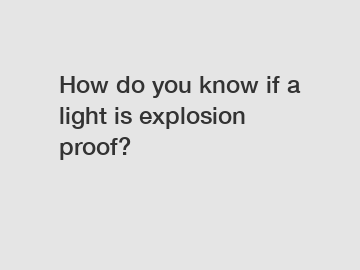How do you know if a light is explosion proof?
How do you know if a light is explosion-proof?
If you are wondering whether a light is explosion-proof or not, there are several factors that you should consider. Firstly, it is important to understand the concept of explosion-proof lighting. Explosion-proof lighting is designed to prevent the ignition of flammable substances in hazardous areas. These lights are specifically constructed and certified to be safe for use in potentially explosive environments.
The first step in determining if a light is explosion-proof is to look for the appropriate certification. In the United States, explosion-proof lights must meet the requirements of the National Electrical Code (NEC) and be certified by an accredited testing laboratory such as Underwriters Laboratories (UL). These certifications ensure that the light has undergone rigorous testing and meets the necessary safety standards.

Furthermore, explosion-proof lights are typically labeled with a specific class and division rating. The class rating indicates the type of hazardous substance that the light is suitable for. For example, Class I lights are suitable for use in areas with flammable gases or vapors, while Class II lights are suitable for areas with combustible dust. The division rating indicates how frequently the hazardous substance is present. Division 1 lights are designed for areas where the hazardous substance is continuously present, while Division 2 lights are suitable for areas where the hazardous substance is present only under abnormal conditions.
In addition to certification and ratings, explosion-proof lights also undergo rigorous testing to ensure their durability and ability to withstand potential explosions. These tests include exposure to extreme temperatures, high pressures, and impact tests. The lights must also be sealed to prevent the entry of flammable substances and be constructed with materials that will not generate sparks.
The importance of using explosion-proof lights cannot be overstated. In hazardous environments, the presence of flammable substances can lead to catastrophic explosions and fires. Explosion-proof lighting provides a safe and reliable source of illumination in these areas, helping to prevent accidents and protect workers.
In conclusion, determining if a light is explosion-proof involves considering the appropriate certifications, class and division ratings, as well as the durability and construction of the light. By choosing explosion-proof lighting, you ensure the safety of your working environment and comply with the necessary safety regulations. Remember, safety should always be a top priority when operating in hazardous areas.
For more information, please visit explosion proof panel board, explosion proof box, explosion proof electrical panel.


